- Home
- Gore Vidal
At Home Page 3
At Home Read online
Page 3
In September 1930, the Ludington Line began regular service. Tickets were sold in railway terminals. Gene personally built the first counter in Washington, using two crates with a board across. Everything was ad hoc. On one occasion, in Philadelphia, passengers from New York to Washington were stretching their legs while passengers from Washington to New York were doing the same. Then each group was shepherded into the wrong plane and the passengers to Washington went back to New York and those to New York back to Washington.
What to serve for lunch? My mother, always dieting, decided that consommé was bound to be popular. Fortunately, in those less litigious times, the first batch of badly scalded passengers gallantly did not sue. Later, hard-boiled eggs and saltine crackers made the sort of lunch that stayed down longest. As the passengers dined, and the plane lurched, and the smell of exhaust filled the cabin, cylindrical cardboard ice-cream containers were tactfully passed around. The fact that what was supposed to contain ice cream was used, instead, for vomit was my first metaphysical experience, an intimation of the skull beneath the skin. During the Second War, as first mate of an army ship in the Aleutians, I would grimly stuff our shaky passengers with crackers and hard-boiled eggs; and it is true: They do stay down longest.
At the end of the first year, the Ludington Line showed the profit duly noted by Time. As organizer and general manager, my father persuaded Amelia Earhart to become a vice president; he also hired Felix Du Pont to be the agent in Washington. He persuaded Herbert Hoover to light up the Washington monument at dusk because, sooner or later, a plane was bound to hit it. On the other hand, he ignored the mandatory fire drills at the Washington terminal on the sensible ground that “We have a real fire,” as one of his mechanics put it, “most every day.” Between New York and Washington, he put up twenty-four billboards. Slowpoke passengers on the Pennsylvania railroad could read, at regular intervals, “If you’d flown Ludington, you’d have been there.” Were it not for Hoover socialism, so successful and busy a passenger airline would have got a mail contract. But Postmaster General Brown chose to give the franchise to Eastern Air Transport, who were eager to carry the mail at eighty-nine cents a mile versus Ludington’s twenty-five cents. But that has always been the American way; who dares question it? The Ludingtons lost heart; and in February 1933 they sold out to Eastern—even though Hoover socialism had been rejected at the polls and there was now a new president, eager to restore prosperity with classic capitalistic measures.
Franklin Roosevelt was something of an aviation freak and, thanks in part to some backstage maneuvering on the part of Amelia Earhart and her friend Eleanor Roosevelt, Eugene L. Vidal became the director of the Bureau of Air Commerce at the age of thirty-eight. He was a popular figure not only in aviation circles but with the press. Henry Ladd Smith wrote: “Gene Vidal had fared so badly at the hands of Postmaster General Brown and the Republican administration that there was a certain poetic justice in his appointment…”*5 But Smith felt that there was more honor than power in the job. The bureau was divided into three parts and Vidal “had all the responsibilities that go with the title, but few of the powers. Unhappy Mr. Vidal took all the blame for mistakes, but he had to share credit with his two colleagues….” I don’t think Gene felt all that powerless, although he certainly took a good deal of blame. Mainly he was concerned with, in Mr. Corn’s words,
the dream of wings for all…in November 1933 [he] announced that the government would soon spend half a million dollars to produce a “poor man’s airplane.” The machine would sell for $700….He planned to launch the project with a grant from Harold Ickes’s Public Works Administration (PWA), one of the numerous government agencies established in the depression to battle unemployment.*6
Although a lot of out-of-work engineers and craftsmen would be employed, Ickes saw nothing public in private planes, and Gene was obliged to use his power to buy planes for the bureau’s inspectors. He ordered five experimental prototypes. The results were certainly unusual. There was one plane whose wings could be folded up; you could then drive it like an automobile. Although nothing came of this hybrid, its overhead rotor was the precursor of the helicopter, still worshiped as a god by the Vietnamese. Finally, there was the Hammond Y-1, which I was to fly.
Along with the glamor of flight, there was the grim fact that planes often crashed and that the bodies of the passengers tended to be unpretty, whether charred or simply in pieces strewn across the landscape. Knute Rockne, Grace Moore, Carole Lombard died; and at least half of the people I used to see in my childhood would, suddenly, one day, not be there. “Crashed” was the word; nothing more was said. As director, Gene was obliged to visit the scenes of every major accident, and he had gruesome tales to report. One survivor sued the bureau because the doctor at the scene of the accident refused to replace in his scrotal sac the testicles that lay nearby.
In 1934 the Democratic senator Hugo Black chaired a Senate committee to investigate the former Republican postmaster general Brown’s dealings with the airlines. Black’s highly partisan committee painted Brown even darker than he was. Yes, he had played favorites in awarding mail contracts but no one could prove that he—or the Grand Old Party—had in any specific way profited. Nevertheless, Jim Farley, the new postmaster general, charged Brown with “conspiracy and collusion” while the president, himself a man of truly superhuman vindictiveness, decided to punish Brown, the Republican party, and the colluded-with airlines.
What could be more punitive—and dramatic—than the cancellation of all U.S. airmail contracts with private companies? Since the army had flown the mail back in 1918, let them fly the mail now. The president consulted the director of Air Commerce, who told him that army flyers did not have the sort of skills needed to fly the mail. After all, he should know; he was one. Undeterred, the president turned to General Benjamin D. Foulois, the chief of the air corps, who lusted for appropriations as all air corps chiefs do; and the general said, of course, the air corps could fly the mail.
* * *
On February 9, 1934, by executive order, the president canceled all airmail contracts; and the Army flew the mail. At the end of the first week, five army pilots were dead, six critically injured, eight planes wrecked. One evening in mid-March, my father was called to the White House. As Gene pushed the president’s wheelchair along the upstairs corridor, the president, his usual airy self, said, “Well, Brother Vidal, we seem to have a bit of a mess on our hands.” Gene always said, “I found that ‘we’ pretty funny.” But good soldiers covered up for their superiors. What, FDR wondered, should they do? Although my father had a deep and lifelong contempt for politicians in general (“They tell lies,” he used to say with wonder, “even when they don’t have to”) and for Roosevelt’s cheerful mendacities in particular, he did admire the president’s resilience: “He was always ready to try something new. He was like a good athlete. Never worry about the last play. Only the next one.” Unfortunately, before they could extricate the administration from the mess, Charles Lindbergh attacked the president; publicly, the Lone Eagle held FDR responsible for the dead and injured army pilots.
Roosevelt never forgave Lindbergh. “After that,” said Gene, “he would always refer to Slim as ‘this man Lindbergh,’ in that condescending voice of his. Or he’d say ‘your friend Lindbergh,’ which was worse.” Although Roosevelt was convinced that Lindbergh’s statement was entirely inspired by the airlines who wanted to get back their airmail contracts, he was too shrewd a politician to get in a shooting match with the world’s most popular hero. Abruptly, on April 20, 1934, Postmaster General Farley let the airlines know that the Post Office was open to bids for mail contracts because, come May, the army would no longer fly the mail. It was, as one thoughtful observer put it, the same old crap game, with Farley not Brown as spoilsman.
In 1935, “lifelong bachelor” (as Time would say) Senator Bronson Cutting was killed in an air crash. He was a popular senator (survived to this day by
his estimable niece, Iris Origo) and the Senate promptly investigated. My father was grilled at length.
The bureau was accused of wasting time and money in a futile effort to develop a “flivver plane” for the masses….Vidal himself did not fare so badly. The committee rebuked him mildly and reported that he appeared “lacking in iron,” but since Vidal was hardly in the position to enforce orders, perhaps even this accusation was unfair.*7
My father’s affection for politicians was not increased by the Senate hearings. But the real prince of darkness had now entered his life, Juan Trippe, and a lifelong struggle began. Even after I was grown, at the Maidstone Club in East Hampton, I used to observe the two men, who never exactly not spoke to each other and yet never did speak.
* * *
Juan Trippe was a smooth-looking man with very dark eyes. Grandson of a bank robber, as Gene liked to recall, Trippe had gone to Yale; got into the airline business in 1926, backed by two Yale friends, C. V. Whitney and William Rockefeller (what on earth do the rich do nowadays?). While Lindbergh was officially associated with my father and the Ludington Line, Slim was also being wooed by Trippe, who had acquired a small Florida–Cuba airline called Pan American. By 1931, Trippe had replaced Keys as the principal robber baron of the airways. Unlike Keys, he was wonderfully well connected socially and politically. For Pan American’s original board, he managed to collect not only a Whitney but a Mellon son-in-law, David Bruce, and Robert Lehman. During Black’s investigation of Brown, Trippe had been caught disguising his profits in what is now standard conglomerate procedure but in those sweet days was fraud; worse, Trippe was a Republican. But smoothness is all, and, in due course, Trippe charmed Farley and Gene; and, for a time, the sly president.
Trippe’s ambitions for Pan American were worldwide. He already had South America; he now wanted the Pacific and China; the Atlantic and Europe. But he would need considerable help from the administration to get the routes nailed securely down. Smoothly, he invited the director of the Bureau of Air Commerce to tour South America. A good time was had by all and, en route, Gene collected a number of exotic decorations from various exotic presidents. Then, back in Washington, Trippe presented Gene with a long list of requests. The guileless director explained to his recent host that the law required competitive bidding and that the United States, unlike old Europe, did not have “chosen instruments.” Naturally, if Pan American wanted to enter in competition with other airlines…
Trippe took his revenge. He went to his friend William Randolph Hearst—no longer a Roosevelt enthusiast—and together they orchestrated a press campaign against Gene Vidal, Jim Farley and FDR—in that order. It is my impression that Lindbergh may have sided with Trippe. There is a curious photograph in The Chosen Instrument.*8 My father is at the center, speaking into a microphone. Trippe is smoothly obsequious to his right, while Igor Sikorsky and Lindbergh are also present. The caption: “Attending the delivery of the Sikorsky S-42 in May 1934,” followed by the names of all those present except for the director, whose endorsement was the point to the photograph. Thanks in part to Trippe’s inspired press campaign, Gene quit the government in 1937, and the bureau was broken up. The Civil Aeronautics Board was then created; on January 1, 1985 it, too, ended, a victim of Reaganism.
Although Trippe got most of the world, he never forgave Gene. Some years later, when my father was put up for membership in Philadelphia’s Racquet Club, Trippe tried to blackball him because Gene’s father’s name was Felix. “A Jewish name,” said Juan, smoothly. Those were racist days. When my father pointed out that in our section of Romano-Rhaetia, Felix is a common Christian name, he inadvertently revealed the family’s darkest secret. Upon arrival (1848) in the Great Protestant Republic, the Roman Catholic Vidals had promptly turned Protestant. Obviously, during the Republic’s high noon, no mass was worth exclusion from the Racquet Club, against whose windows were pressed so many wistful Kennedy and Lee (born Levy) noses. Recently, a journalist told me that while interviewing Trippe, he noticed the old man was reading one of my books. When the journalist told him that the author was Gene Vidal’s son, Trippe shook his head with wonder. “My, my,” he said. “Hard to believe, isn’t it?” Oh, there were real shits in those days.
3
I have no memory of Lindbergh. But Amelia Earhart was very much a part of my life. She wrote poetry and encouraged me to write, too. She had a beautiful speaking voice, which I am sure I would have recognized during the war if she had really been, as certain fabulists believe, Tokyo Rose, a captive of the Japanese. Since she usually dressed as a boy, it was assumed that she had what were then called Sapphic tendencies. I have no idea whether or not she did but I do know that she wore trousers because she thought her legs were ugly; and if she were truly Sapphic, I doubt that she would have been so much in love with my father. She had milk-white eyelashes.
In the fall of 1936, Amelia, Gene, and I went to the Army-Navy game at West Point. On the way back, as her fans peered excitedly into our train compartment, she described how she planned to fly around the world, following, more or less, the equator. I asked her what part of the flight worried her the most. “Africa,” she said. “If you got forced down in those jungles, they’d never find you.” I said that the Pacific looked pretty large and wet to me. “Oh, there are always islands,” she said. Then she asked Gene: “Wouldn’t it be wonderful to just go off and live on a desert island?” He rather doubted it. Then they discussed just how you could survive; and what would you do if there was no water? and if there was no water, you would have to make a sun-still and extract salt from sea water and how was that done? As we approached Grand Central Station, I suddenly decided that I wanted a souvenir of Amelia. Shortly before she left on her flight around the world, she sent me the blue-and-white checked leather belt that she often wore. She gave my father her old watch. She also made a new will, as she usually did before a dangerous flight. She left Gene her California house, on condition that if he didn’t want it (he didn’t), he would give it to her mother, something she did not trust G.P., her husband, to do.*9
* * *
Although my father was as fond of conspiracy theories as any other good American, he rejected most of the notions that still circulate about Amelia’s last flight. Of course, he was at a disadvantage: He knew something about it. When Amelia’s plane vanished on July 2, 1937, somewhere between Lae, New Guinea, and Howland Island in the Pacific—where there are all those islands—the president sent the navy to look for her. He also asked Gene to help out and act as a sort of coordinator. If Amelia had been on a spy mission for the American government, as is still believed in many quarters,*10 the commander in chief hadn’t been told about it. Years later, Eleanor Roosevelt used to talk a lot about Amelia. When I asked her if she had ever been able to find out anything, she said no. More to the point, since Mrs. Roosevelt had been devoted to Amelia, if there had been a secret mission, Mrs. Roosevelt would have certainly revealed it after the war and demanded all sorts of posthumous recognition for her friend. But Mrs. Roosevelt was certain that there had been no spy mission; on the other hand, she—like my father—thought there was something fishy about the whole business.
Shortly before Amelia left the States, she told my father that since she would have to take a navigator with her, she was going to hire Fred Noonan, formerly Pan American’s chief navigator. Gene was alarmed: Noonan was a drunk. “Take anyone but Noonan,” he said. “All right then,” said Amelia, “why not you?” To Gene’s surprise she wasn’t joking. Although Gene had recently divorced my mother and G.P. was simply Amelia’s manager, Gene’s affection for Amelia was not equal to her love for him. “I’m not that good a navigator,” he said. She then hired Noonan, who swore he was forever off the sauce. The flight began.
From India, Amelia rang G.P. and Gene together. She reported “personnel trouble”: code for Noonan’s drinking. Gene advised her to stop the flight. But she chose to keep on. Amelia rang agai
n; this time from New Guinea. “Personnel trouble” had delayed her next hop—to Howland Island. This time both Gene and G.P. told her to abandon the flight. But she thought “personnel” might be improving. She was wrong. The night before they left Lae, Noonan was drunk; worse, he had had only forty-five minutes’ sleep. When they took off, he was still drunk.
* * *
Gene’s theory of what happened is this: Amelia was going through a disagreeable early menopause; she deeply disliked her husband; she hated the publicness of her life and she was, at some romantic level, quite serious about withdrawing to a desert island—symbolically if not literally. Years earlier, she had made a number of conditions when she allowed G.P. to marry her. The marriage was to be, as they called it then, “open.” Also, “I may have to keep some place where I can go to be by myself now and then, for I cannot guarantee to endure at all times the confinements of even an attractive cage.” Finally, Gene thought it unlikely that even a navy so sublimely incompetent that, four years later, it would allow most of its fleet to be sunk at Pearl Harbor, would ever have engaged such a nervy lady to spy on Japan, while she would have pointed out that a pioneer circumnavigation of the globe was quite enough for one outing.
According to Gene, there were only two mysteries. One of Amelia’s last radio messages was, “742 from KHAQQ: We must be on you but we cannot see you. Gas is running low. Been unable to reach you by radio. Flying at one thousand feet. One half-hour’s gas left.” Gene said that this was not a true report. She had a good deal more than a half-hour’s gas left. Why did she lie? The second mystery was that of the radio frequency. Amelia’s last message was at 8:46 A.M.; after that, some fourteen minutes passed with her frequency still coming in strong at what is known as “maximum 5.” “Then,” said Gene, “the frequency didn’t break off, the way it does when you crash. Someone switched it off.” So what happened? It was Gene’s hunch that she had indeed found an island—and landed. “But what about Fred Noonan?” I asked. “He sounds even worse than G.P.” Gene’s response was grim: “If Amelia wanted to get rid of him, she’d have got rid of him. Hit him over the head with one of his bottles. She was like that.”

 The Golden Age: A Novel
The Golden Age: A Novel Death Before Bedtime
Death Before Bedtime Burr
Burr The Last Empire
The Last Empire Empire: A Novel
Empire: A Novel The Selected Essays of Gore Vidal
The Selected Essays of Gore Vidal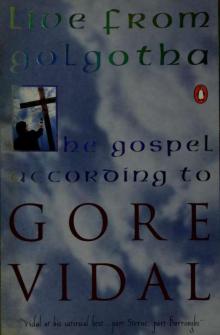 Live From Golgotha
Live From Golgotha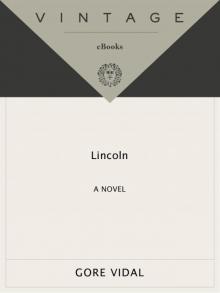 Lincoln
Lincoln Death Likes It Hot
Death Likes It Hot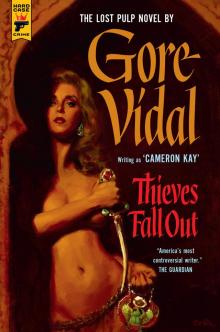 Thieves Fall Out (Hard Case Crime)
Thieves Fall Out (Hard Case Crime) Point to Point Navigation
Point to Point Navigation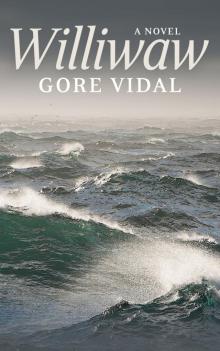 Williwaw
Williwaw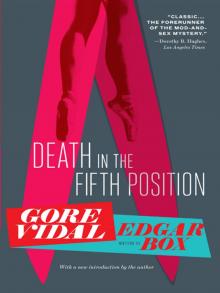 Death in the Fifth Position
Death in the Fifth Position In a Yellow Wood
In a Yellow Wood Julian
Julian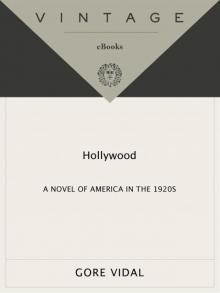 Hollywood
Hollywood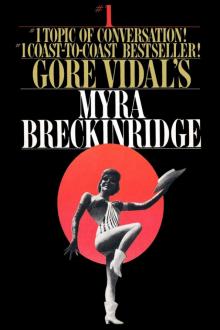 Myra Breckinridge
Myra Breckinridge Messiah
Messiah The Second American Revolution and Other Essays 1976--1982
The Second American Revolution and Other Essays 1976--1982 Homage to Daniel Shays
Homage to Daniel Shays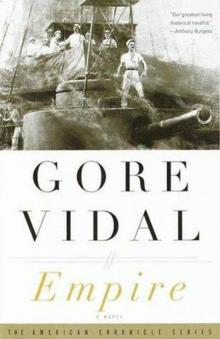 Empire
Empire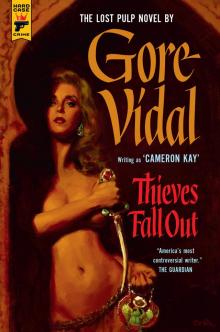 Thieves Fall Out
Thieves Fall Out 1876
1876 The City and the Pillar
The City and the Pillar The Golden Age
The Golden Age At Home
At Home